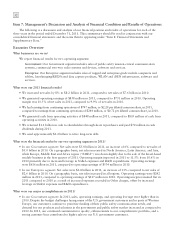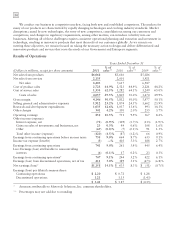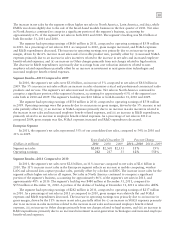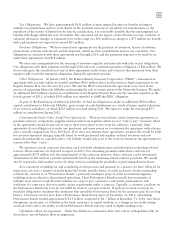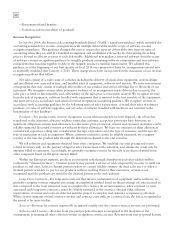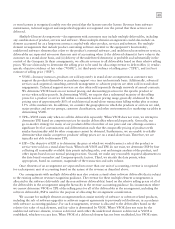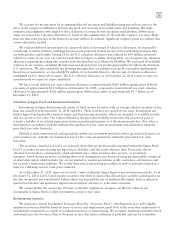Motorola 2011 Annual Report Download - page 48
Download and view the complete annual report
Please find page 48 of the 2011 Motorola annual report below. You can navigate through the pages in the report by either clicking on the pages listed below, or by using the keyword search tool below to find specific information within the annual report.
42
We maintained all of the U.S. pension liabilities and the majority of the non-U.S. pension liabilities following
the distribution of Motorola Mobility on January 4, 2011, and following the sale of certain assets and liabilities of
the Networks business to NSN on April 29, 2011. Retirement benefits are further discussed in the “Significant
Accounting Policies—Retirement Benefits” section.
Investing Activities
Net cash provided by investing activities was $2.4 billion in 2011, compared to $523 million in 2010 and net
cash used for investing activities of $531 million in 2009. The $1.9 billion increase in net cash provided by investing
activities from 2010 to 2011 was primarily due to: (i) a $1.1 billion increase in cash received from net sales of Sigma
Fund investments, and (ii) $860 million increase in cash received from sales of investments and businesses primarily
relating to the sale of certain assets and liabilities of the Networks business.
Sigma Fund: We and our wholly-owned subsidiaries invest most of our U.S. dollar-denominated cash in a
fund (the “Sigma Fund”) that allows us to efficiently invest our cash around the world. We had net proceeds of $1.5
billion from sales of Sigma Fund investments in 2011, compared to $453 million in net proceeds from sales of Sigma
Fund investments in 2010 and $922 million of net purchases of Sigma Fund investments in 2009. The aggregate fair
value of Sigma Fund investments was $3.2 billion at December 31, 2011 (including $1.3 billion held by us outside
the U.S.), compared to $4.7 billion at December 31, 2010 (including $1.9 billion held by us outside the U.S.).
The Sigma Fund portfolio is managed by four independent investment management firms. The investment
guidelines of the Sigma Fund require that purchased investments must be in high-quality, investment grade (rated at
least A/A-1 by Standard & Poor’s or A2/P-1 by Moody’s Investors Service), U.S. dollar-denominated fixed income
obligations, including certificates of deposit, commercial paper, government bonds, corporate bonds and asset- and
mortgage-backed securities. Under the Sigma Fund’s investment policies, except for obligations of the U.S.
government, agencies and government-sponsored enterprises, no more than 5% of the Sigma Fund portfolio is to
consist of securities of any one issuer. The Sigma Fund’s investment policies further require that floating rate
investments must have a maturity at purchase date that does not exceed thirty-six months with an interest rate that
is reset at least annually. The average interest rate reset of the investments held by the funds must be 120 days or
less. The actual average effective maturity of the portfolio (excluding cash and defaulted securities) was less than
one month at both December 31, 2011, and December 31, 2010.
Investments in the Sigma Fund were primarily fixed income securities carried at fair value. At December 31,
2011, $3.2 billion of the Sigma Fund investments were classified as current in our consolidated balance sheets,
compared to $4.7 billion at December 31, 2010. The weighted average maturity of the Sigma Fund investments
classified as current was less than one month (excluding cash of $264 million) at December 31, 2011, compared to
1 month (excluding cash of $2.4 billion and defaulted securities) at December 31, 2010. A majority of the Sigma
Fund’s cash balance at December 31, 2010 was reserved for the distribution of Motorola Mobility. At
December 31, 2011, 100% of the Sigma Fund investments were invested in cash and U.S. government, agency and
government-sponsored enterprise obligations. This reflects a strategic decision to prioritize capital preservation
rather than investment income.
In 2011, we recorded a de minimus loss from the Sigma Fund investments in Other income (expense) in the
consolidated statement of operations, compared to a gain from the Sigma Fund investments of $11 million in 2010.
Securities with a maturity greater than twelve months and defaulted securities have been classified as
non-current in our consolidated balance sheets. At December 31, 2011, no Sigma Fund investments were classified
as non-current due to the sales of the non-current securities during 2011. At December 31, 2010, $70 million of the
Sigma Fund investments were classified as non-current.
We continuously assess our cash needs and continue to believe that the balance of cash and cash equivalents,
short-term investments and investments in the Sigma Fund classified as current are more than adequate to meet our
current operating requirements over the next twelve months.
Strategic Acquisitions and Investments: We used $32 million cash for acquisitions and new investment
activities in 2011, compared to $23 million in 2010 and $17 million in 2009. The cash used in 2011, 2010, and
2009 was for small strategic investments.


